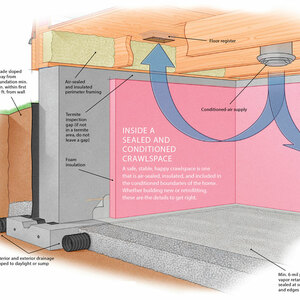I’m looking for suggestions on how to seal a gap between the sill plate and the foundation in my house which was built in 1972 with no insulation strip or caulk. It has the typical cement seal up against the sill from the block on the inside that has cracked and separated over the years. At first, after removing the cement seal, I was shoving silicone caulk in as best I could, then laying a felt insulation strip over the opening and holding that in place with a nailed piece of quarter round. I don’t know how effective that is, and it doesn’t fill the whole space to the outside. In spots I could see daylight from the inside, but can’t get to it from the outside as it is above the shingle line. Any suggestion or material (short of jacking the house up and laying in an insulation strip) would be appreciated.
Discussion Forum
Discussion Forum
Up Next
Video Shorts
Featured Story

Fine Homebuilding is excited to be the official media partner of the 2024 Building Science Symposium series! This event offers builders, tradesmen, architects, designers and suppliers to discuss topics ranging…
Featured Video
SawStop's Portable Tablesaw is Bigger and Better Than BeforeHighlights
"I have learned so much thanks to the searchable articles on the FHB website. I can confidently say that I expect to be a life-long subscriber." - M.K.

















Replies
The size of this gap is the key to the answer. I have used spray foam from a tube several times for this when the gaps are 1/4" to 1/2" but it sounds like yours are far less. And what you call typical cement seal is unfamiliaar to me. Is this acrawl space only or interior space?
Here is where I am going with this - you could get a hired gun, that is, someone with a spray gun outfit to spray foam insulation to the entire wall and sill if that is an option like in a crawl space.
Alternatively, ( this could possibly make a real mess...) Gorilla glue will also faom up when mositure is present. It is a ployurethene glue with fewer expanders than poly foam but it still foams.
And it has a low enough viscosity that you could conceivably load it into a syringe with a large tip to squeeze into opennings/cracks too small for a foam tip. The downside is that it might run down the wall and make a mess. Wear rubber gloves.
Welcome to the
Taunton University of Knowledge FHB Campus at Breaktime.
where ...
Excellence is its own reward!
If you've got more time than money, just use some sort of a stick to pack fiberglass insulation in there. This should be doable for anything wider than 1/4" or so. Otherwise foam is probably the way to go.
Note that you don't need to fill the entire space. Push in foam backer rod from each side an inch or two, then fill to the surface with squirt foam.